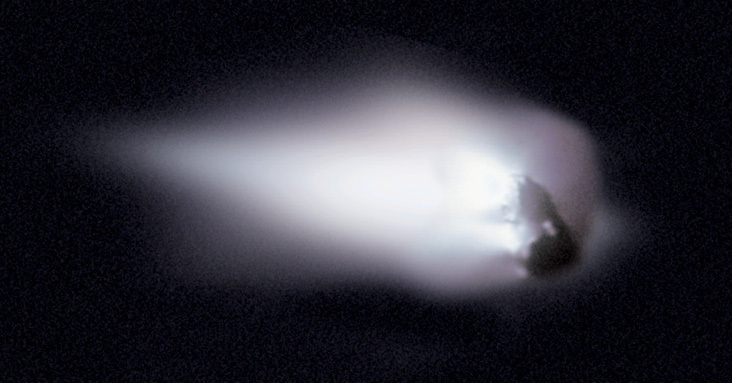Comets That Keep Returning to Orbit Over and Over Again

In 1986, the European spacecraft Giotto became one of the first spacecraft ever to encounter and photograph the nucleus of a comet, passing and imaging Halley's nucleus every bit it receded from the Sun. Paradigm Credit: Halley Multicolor Camera Team, Giotto Project, ESA
1P/Halley is ofttimes called the most famous comet because it marked the first fourth dimension astronomers understood comets could be repeat visitors to our night skies. Astronomers take at present linked the comet'due south appearances to observations dating back more than 2,000 years.
Halley was last seen in Earth's skies in 1986 and was met in space past an international fleet of spacecraft. Information technology volition return in 2061 on its regular 76-year journeying effectually the Sun.
The History of Halley's Comet
Until the time of English astronomer Edmond Halley (1656-1742), comets were believed to make only one pass through the solar system.
But in 1705, Halley used Isaac Newton'southward theories of gravitation and planetary motions to compute the orbits of several comets. Halley constitute the similarities in the orbits of bright comets reported in 1531, 1607 and 1682 and he suggested that the trio were actually a single comet making render trips. Halley correctly predicted the comet's render in 1758-1759 — xvi years after his expiry — and history'south beginning known "periodic" comet was later named in his accolade.
The comet has since been connected to ancient observations going back more 2,000 years. Information technology is featured in the famous Bayeux tapestry, which chronicles the Battle of Hastings in 1066.
In 1986, an international fleet spacecraft met the comet for an unprecedented study from a variety of vantage points. The scientific discipline fleet included Japan's Suisei and Sakigake spacecraft, the Soviet Union'south Vega 1 and Vega two (repurposed afterward a successful Venus mission), the international ISEE-iii (Water ice) spacecraft and the European Infinite Agency'southward Giotto. NASA'south Pioneer 7 and Pioneer 12 as well contributed the the compensation of scientific discipline data nerveless.
Halley's Connectedness to Falling star Showers
Each time Halley returns to the inner solar system its nucleus sprays water ice and rock into space. This debris stream results in two weak meteor showers each yr: the Eta Aquarids in May and the Orionids in October.
Size
Halley'due south dimensions are most 9.3 by 5 miles (15 kilometers past 8 kilometers). Information technology is one of the darkest, or least cogitating, objects in the solar system. Information technology has an albedo of 0.03, which means that it reflects only iii% of the calorie-free that falls on information technology.
Orbit
Comet Halley moves backward (reverse to Earth's motion) around the Dominicus in a plane tilted 18 degrees to that of the Globe's orbit. Halley's backward, or retrograde, motion is unusual amidst short-period comets, as is its greatest distance from the Dominicus (aphelion) is beyond the orbit of Neptune.
Halley'south orbit period is, on boilerplate, 76 Globe years. This corresponds to an orbital circumference around the Dominicus of about 7.6 billion miles (12.two billion kilometers). The period varies from appearance to advent because of the gravitational effects of the planets. Measured from ane perihelion passage to the side by side, Halley's period has been as brusque equally 74.42 years (1835-1910) and as long every bit 79.25 years (451-530).
The comet's closest approach to Earth occurred in 837, at a distance of 0.033 AU (3.07 meg miles or 4.94 one thousand thousand kilometers). At that time, Apr 10, 837, Halley reached a total apparent effulgence of about magnitude -3.v, near that of Venus at greatest brilliance. The light of Halley was spread over an extended area, however, then its surface brightness was less than that of Venus.
During its 1986 appearance, Halley'due south nearest approach to Earth occured on the outbound leg of the trip at a distance of 0.42 AU (39 one thousand thousand miles or 63 million kilometers). It was slightly brighter than the northward star Polaris, merely again spread over a much larger area than a point-like star.
At aphelion in 1948, Halley was 35.25 AU (3.28 billion miles or 5.27 billion kilometers) from the Sunday, well beyond the distance of Neptune. The comet was moving 0.91 kilometers per second (2,000 mph). At perihelion on February ix, 1986, Halley was but 0.5871 AU (87.8 1000000 km: 54.half-dozen million miles) from the Sun, well inside the orbit of Venus. Halley was moving at 122,000 mph (54.55 kilometers per second).
Lifetime
With each orbit around the Sun, a comet the size of Halley loses an estimated three to 10 feet (1 to 3 meters) of material from the surface of its nucleus. Thus, as a comet ages, it eventually dims in appearance and may lose all the ices in its nucleus. The tails disappear at that stage, and the comet finally evolves into a dark mass of rocky cloth or perhaps dissipates into grit.
Scientists calculate that an average periodic comet lives to complete about 1,000 trips around the Dominicus. Halley has been in its present orbit for at least sixteen,000 years, but information technology has shown no obvious signs of aging in its recorded appearances.
How Comet 1P/Halley Got Its Name
Comets are usually named for their discoverer(due south) or for the name of the observatory/telescope used in the discovery. Since Halley correctly predicted the return of this comet — the offset such prediction — information technology is named for him to honor him. The letter "P" indicates that Halley is a "periodic" comet. Periodic comets have an orbital menses of less than 200 years.
Source: https://solarsystem.nasa.gov/asteroids-comets-and-meteors/comets/1p-halley/in-depth/
0 Response to "Comets That Keep Returning to Orbit Over and Over Again"
Postar um comentário